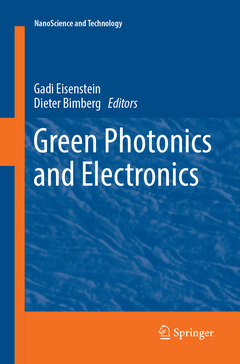Green Photonics and Electronics, 1st ed. 2017 NanoScience and Technology Series
Coordonnateurs : Eisenstein Gadi, Bimberg Dieter

This books focuses on recent break-throughs in the development of a variety of photonic devices, serving distances ranging from mm to many km, together with their electronic counter-parts, e.g. the drivers for lasers, the amplifiers following the detectors and most important, the relevant advanced VLSI circuits. It explains that as a consequence of the increasing dominance of optical interconnects for high performance workstation clusters and supercomputers their complete design has to be revised. This book thus covers for the first time the whole variety of interdependent subjects contributing to green photonics and electronics, serving communication and energy harvesting. Alternative approaches to generate electric power using organic photovoltaic solar cells, inexpensive and again energy efficient in production are summarized.
In 2015, the use of the internet consumed 5-6% of the raw electricity production in developed countries. Power consumption increases rapidlyand without some transformational change will use, by the middle of the next decade at the latest, the entire electricity production. This apocalyptic outlook led to a redirection of the focus of data center and HPC developers from just increasing bit rates and capacities to energy efficiency. The high speed interconnects are all based on photonic devices. These must and can be energy efficient but they operate in an electronic environment and therefore have to be considered in a wide scope that also requires low energy electronic devices, sophisticated circuit designs and clever architectures. The development of the next generation of high performance exaFLOP computers suffers from the same problem: Their energy consumption based on present device generations is essentially prohibitive.
Gadi Eisenstein holds the Seiden chair in Optoelectronics and is the director of the Russel Berrie nanotechnology Institute at Technion. He received his PhD in 1980 from the University of Minnesota and then joined the AT&T Bell Laboratory Crawford Hill Research Laboratory where he worked for 10 years at the Photonic Circuits department before joining Technion in 1989. Professor Eisenstein was a guest professor at the University of Minnesota from 1997 till 1999. He was awarded the Alexander von Humboldt Award in 2007 at the Technical University Berlin where he has spent a sabbatical leave as guest Professor in 2011. In 2012 he was invited back to TU-Berlin as a return Humboldt Awardee. In 2012, he was elected Foreign Member at The Istituto Veneto di Scienze, Lettere ed Arti-a prestigious Venetian academy and in 2014, he received the William Streifer Award of the IEEE for seminal contributions to dynamics and noise properties of semiconductor lasers.
Dieter H. Bimberg received the Diploma in physics and the Ph.D. degree from Goethe University, Frankfurt, in 1968 and 1971, respectively. From 1972 to 1979 he held a Principal Scientist position at the Max Planck-Institute for Solid State Research in Grenoble/France and Stuttgart. In 1979 he was appointed as Professor of Electrical Engineering, Technical University of Aachen.
Since 1981 he holds the Chair of Applied Solid State Physics at Technical University of Berlin. He was elected in 1990 Excecutive Director of the Solid State Physics Institute at TU Berlin, a position he hold until 2011. Since 2004 he is director of the Center of Nanophotonics at TU Berlin. From 2006 -2011 he was the chairman of the board of the German Federal Government Centers of Excellence in Nanotechnologies.
His honors include the Russian State Prize in Science and Technology 2001, his election to the German Academy of Sciences Leopoldina in 2004, to the Russian Academy of Sciences in 2011 and to the US National Academy of
Date de parution : 09-2018
Ouvrage de 291 p.
15.5x23.5 cm
Date de parution : 11-2017
Ouvrage de 291 p.
15.5x23.5 cm
Thème de Green Photonics and Electronics :
Mots-clés :
Energy Efficient System Architecture; Energy-Efficient Optical Communication; Secure Power Management and Delivery; Reducing Internet Energy Consumption; High Performance exaFLOP Computers; Nanophotonic Approach to Energy; Energy-efficient Chip Design; Energy-efficient VCSELs; Computer Architecture
